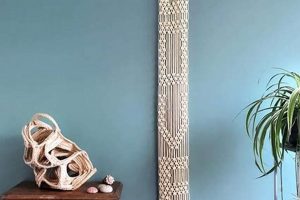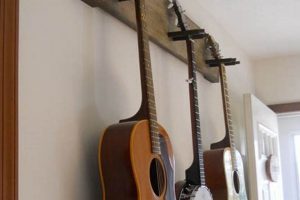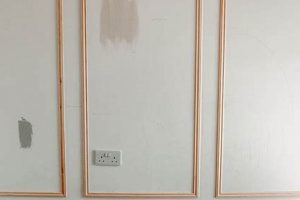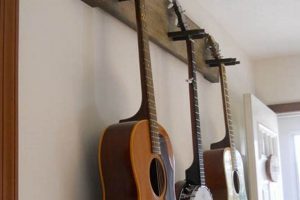Constructing a vertical surface from a mixture of cement, aggregates, and water through individual effort is a project frequently undertaken to enhance residential or commercial spaces. This endeavor allows for customization in texture, color, and form, adapting to diverse aesthetic preferences and functional needs. Examples of this process include building garden retaining structures, creating unique interior accent features, or forming durable exterior fencing.
The appeal of erecting such a structure independently lies in the potential for cost savings compared to professional installation, the satisfaction of personal creation, and the ability to tailor the finished product to specific requirements. Historically, cement-based construction has been a staple of human ingenuity, evolving from rudimentary mixtures to sophisticated formulations that provide strength and longevity. This method offers both practical and aesthetic advantages, from enhancing property value to providing a blank canvas for artistic expression.
Subsequent sections will delve into crucial aspects of this type of project. Topics covered will include necessary materials and tools, safety precautions to observe, step-by-step construction methodologies, and common challenges encountered during the process along with effective solutions. Furthermore, techniques for surface finishing, texturing, and waterproofing will be examined to ensure a professional and lasting outcome.
Essential Considerations for Cement-Based Vertical Structures
The successful implementation of cement-based vertical structures requires meticulous planning and execution. Attention to detail throughout the process will contribute to structural integrity and aesthetic appeal.
Tip 1: Material Selection: Choose appropriate cement, aggregate, and admixture types based on the intended application and environmental conditions. Portland cement Type I is suitable for general construction, while Type III offers faster setting times. Aggregate size and gradation influence workability and final strength.
Tip 2: Formwork Design: The formwork must withstand the hydrostatic pressure of the wet mixture. Ensure proper bracing and sealing to prevent bulging or leakage. Consider using release agents to facilitate formwork removal without damaging the surface.
Tip 3: Mixture Proportioning: Precise water-cement ratios are critical for achieving the desired strength and durability. Excessive water reduces strength and increases shrinkage cracking. Consult reputable mix design guides for optimal proportions.
Tip 4: Reinforcement Placement: If structural integrity demands reinforcement, employ appropriate steel reinforcement bars or mesh. Maintain adequate concrete cover to protect the steel from corrosion and ensure proper bonding.
Tip 5: Placement Techniques: Consolidate the mixture in layers using vibration to eliminate air voids and ensure proper compaction. Avoid over-vibration, which can cause segregation. Uniform placement prevents weak areas.
Tip 6: Curing Process: Proper curing is essential for cement hydration and strength development. Maintain moisture by covering the surface with wet burlap, plastic sheeting, or applying curing compounds. Duration depends on cement type and ambient temperature.
Tip 7: Surface Finishing: Employ appropriate finishing techniques to achieve the desired aesthetic. Options include troweling, brushing, or applying textured coatings. Timing is crucial for achieving the intended finish.
Tip 8: Safety Precautions: Cement is caustic and can cause skin irritation. Wear appropriate personal protective equipment, including gloves, eye protection, and respiratory protection when handling cement and its mixtures.
Adhering to these considerations maximizes the potential for a durable, structurally sound, and visually appealing finished product. Careful attention to each stage, from material selection to curing, contributes to the overall success of the project.
The following sections will explore advanced techniques and address common troubleshooting scenarios.
1. Mixture Composition
The mixture composition represents a critical determinant in the successful execution of a self-initiated cement-based vertical construction project. The proportion of cement, aggregates (both fine and coarse), water, and any admixtures directly affects the workability of the wet mixture, its setting time, ultimate compressive strength, durability, and aesthetic appearance. An improperly balanced composition will inevitably lead to structural weaknesses, surface defects, or premature deterioration of the finished vertical surface. For example, an excessive water-cement ratio reduces strength and increases permeability, rendering the wall vulnerable to freeze-thaw damage. Conversely, insufficient water compromises workability, making placement and consolidation challenging, leading to internal voids and reduced density.
The selection of aggregate type and size also has a profound impact. Fine aggregates contribute to workability and surface finish, while coarse aggregates provide bulk and enhance strength. The grading of aggregates the distribution of particle sizes affects the packing efficiency of the mixture, influencing its density and resistance to cracking. The inclusion of supplementary cementitious materials, such as fly ash or slag, can improve long-term durability and reduce the environmental impact of the structure. Real-world examples include the use of lightweight aggregates to reduce the overall weight of the vertical construction or the incorporation of fiber reinforcement to enhance resistance to tensile stresses and cracking.
In conclusion, the formulation of a suitable mixture is paramount when undertaking cement-based vertical surface construction. A comprehensive understanding of the individual components and their interactions is essential to achieve optimal performance characteristics. Challenges inherent in achieving an optimal mixture composition can be addressed through thorough research, adherence to established mix design principles, and careful monitoring of the mixture’s properties throughout the construction process. This foundational knowledge enables individuals to realize durable, aesthetically pleasing, and structurally sound independent vertical constructions.
2. Formwork Integrity
Formwork integrity is fundamentally linked to the successful creation of a self-directed cement-based vertical surface. The formwork serves as the mold that defines the shape, dimensions, and surface quality of the resulting structure. Therefore, its stability, strength, and proper construction are paramount to achieving the desired outcome. Any deficiencies in the formwork directly translate into imperfections in the finished surface, potentially compromising structural integrity and aesthetic appeal.
- Structural Resistance to Hydrostatic Pressure
Wet cement mixtures exert significant hydrostatic pressure. The formwork must withstand this force without deformation or failure. Insufficient bracing or inadequate material selection can lead to bulging, bowing, or complete collapse. For example, constructing a tall vertical surface requires progressively stronger formwork as the fill height increases. Failure to account for this pressure can result in costly and potentially dangerous incidents, requiring complete reconstruction of the structure. Properly designed and constructed formwork ensures dimensional accuracy and prevents structural compromise.
- Water-Tightness and Leakage Prevention
Formwork must be sufficiently sealed to prevent the leakage of cement slurry. Slurry loss not only reduces the density and strength of the structure but also creates unsightly surface blemishes and weakens the bond between successive layers. Employing sealing agents, tight joints, and appropriate formwork materials are essential. Instances of honeycomb concrete or exposed aggregate are often direct consequences of inadequate formwork sealing, demanding costly repairs and compromising long-term durability.
- Dimensional Accuracy and Alignment
The dimensional accuracy of the formwork directly impacts the final dimensions and alignment of the finished surface. Incorrect measurements, misaligned panels, or inadequate support systems can result in walls that are out of plumb, uneven in thickness, or deviate from the intended design. Precise construction and careful monitoring are critical for achieving the desired geometric characteristics. Deviation from the specified dimensions can lead to functional issues and aesthetic dissatisfaction, particularly in visible portions of the construction.
- Surface Finish and Texture Transfer
The surface texture of the formwork is often transferred to the surface of the wet mixture. Therefore, the selection of formwork material influences the texture of the concrete surface. The choice of smooth formwork material will help create smooth cement base surface. Alternatively, textured formwork liners can impart decorative patterns or textures to the finished surface, expanding the aesthetic possibilities. Proper treatment of the formwork, including the application of release agents, is necessary to ensure easy removal without damaging the surface and can enhance the texture.
In conclusion, the integrity of the formwork is integral to the successful implementation of cement-based vertical surfaces. By carefully considering the structural resistance, water-tightness, dimensional accuracy, and surface finish characteristics of the formwork, individuals can mitigate potential problems and achieve superior results. The attention to detail in formwork design and construction serves as a key determinant in the overall quality and longevity of the finished project.
3. Reinforcement Strategies
The implementation of suitable reinforcement strategies is crucial in the construction of cement-based vertical surfaces. Reinforcement serves to enhance the tensile strength and structural integrity of the finished product, mitigating cracking and improving load-bearing capacity. Therefore, the selection and application of appropriate reinforcement techniques are paramount to ensuring the longevity and safety of such self-directed construction projects.
- Steel Reinforcement Bars (Rebar)
Rebar is the most common form of reinforcement, providing significant tensile strength to resist bending and shear forces. The diameter and spacing of rebar are determined by load calculations and building codes. For example, in a retaining structure, vertically placed rebar resists lateral earth pressure, while horizontally placed rebar resists shrinkage cracking. Inadequate rebar placement or insufficient bar size can lead to structural failure under load.
- Welded Wire Mesh (WWM)
WWM provides a distributed reinforcement network, controlling cracking due to shrinkage and temperature fluctuations. It is often used in walls that are not subject to high structural loads. For example, a garden wall constructed with WWM resists cracking from freeze-thaw cycles and soil settlement. The gauge and spacing of the wires dictate its effectiveness. Improper overlap of WWM sheets can create weak zones and increase the risk of cracking.
- Fiber Reinforcement
Fiber reinforcement, typically consisting of synthetic or steel fibers, is incorporated into the cement mixture to enhance its resistance to cracking and impact. Fibers provide multi-directional reinforcement, improving the toughness and ductility of the material. For instance, adding polypropylene fibers to the mixture of a wall increases its resistance to cracking caused by plastic shrinkage. The type and dosage of fiber are critical factors influencing the effectiveness of this technique.
- Pre-Tensioning and Post-Tensioning
Pre-tensioning and post-tensioning techniques involve applying tensile stress to reinforcement before or after the cement mixture has hardened. This pre-compresses the cement, increasing its load-bearing capacity. Although less common in small-scale construction, these techniques can be applied to create exceptionally strong vertical surfaces. An example is using post-tensioned cables in a tall retaining structure to resist significant lateral forces. The application of these methods requires specialized knowledge and equipment.
The appropriate selection and application of reinforcement strategies significantly enhance the performance and lifespan of self-directed cement-based vertical surfaces. Failure to adequately reinforce such structures can lead to premature failure, posing safety risks and necessitating costly repairs. Therefore, a thorough understanding of reinforcement principles and techniques is essential for successful project execution.
4. Placement Techniques
Placement techniques are a critical determinant in the structural integrity and aesthetic quality of any independently constructed cement-based vertical structure. The manner in which the mixture is deposited and consolidated within the formwork directly affects the density, homogeneity, and surface finish of the final product. Improper placement can lead to segregation of aggregates, the formation of air voids, and weak zones, all of which compromise the durability and load-bearing capacity of the wall. For example, dropping large volumes of the mixture from excessive heights can cause coarse aggregates to settle preferentially, creating non-uniformity throughout the wall. A failure to properly consolidate the mixture will leave behind air pockets, reducing the effective cross-sectional area and weakening the structure. Therefore, a meticulous approach to placement is essential for achieving a successful outcome.
Effective placement techniques necessitate the layering of the mixture in manageable lifts, typically ranging from 12 to 18 inches in depth. Each layer should be thoroughly consolidated through vibration, either using internal vibrators or external form vibrators. Internal vibrators are inserted directly into the mixture, expelling trapped air and ensuring close contact between the mixture and the formwork. External form vibrators transmit vibrations through the formwork itself, offering a means of consolidation when internal vibration is impractical. Over-vibration, however, can be as detrimental as under-vibration, leading to segregation and surface defects. Real-world applications include using a concrete pump and hose to deposit the mixture in difficult-to-reach areas of the formwork, followed by careful vibration to ensure uniform consolidation. Skilled operators can often identify subtle variations in the mixture consistency and adjust vibration techniques accordingly to optimize the final product.
In summary, the success of a cement-based vertical surface hinges significantly on the proper implementation of placement techniques. By employing controlled layering, appropriate vibration methods, and vigilant monitoring of the mixture consistency, individuals can mitigate the risks of structural defects and achieve a durable, aesthetically pleasing outcome. Addressing the challenges inherent in mixture placement requires a combination of practical experience, attention to detail, and a thorough understanding of material behavior. Mastery of these techniques is a cornerstone of successful independent cement-based vertical surface construction.
5. Curing Methods
Curing methods represent a critical post-placement procedure in the construction of cement-based vertical surfaces. These techniques directly impact the hydration process, influencing the strength, durability, and overall quality of the finished structure. The application of appropriate curing protocols is essential to mitigating cracking and maximizing the longevity of self-directed construction efforts.
- Water Curing
Water curing involves maintaining a continuous supply of moisture on the cement surface, promoting hydration. This can be achieved through ponding, spraying, or covering the surface with wet burlap or absorbent mats. For example, in warm weather, constant wetting prevents rapid evaporation and subsequent cracking. Inadequate water curing leads to reduced strength and increased permeability, rendering the structure susceptible to deterioration from freeze-thaw cycles and chemical attack. Water curing is particularly crucial during the early stages of hydration when strength gain is most rapid.
- Membrane Curing
Membrane curing involves applying a liquid compound to the cement surface, forming an impermeable barrier that prevents moisture loss. These compounds are typically composed of wax-based or resin-based materials. For instance, membrane curing is well-suited for large vertical surfaces where maintaining continuous wetting is impractical. The effectiveness of membrane curing depends on the uniformity of the application and the integrity of the membrane. Any breaches in the membrane compromise its ability to retain moisture and can lead to localized areas of reduced strength.
- Steam Curing
Steam curing accelerates the hydration process by providing both heat and moisture. This method is generally employed in precast concrete operations, where rapid strength gain is desired. While less common in self-directed projects, steam curing can be implemented on a small scale using portable steam generators. For example, steam curing can significantly reduce the time required to achieve sufficient strength for formwork removal in cold weather conditions. Strict control over temperature and humidity is essential to prevent adverse effects, such as delayed ettringite formation.
- Plastic Sheeting
Covering the cement surface with plastic sheeting is a straightforward and cost-effective curing method. The sheeting traps moisture, creating a humid environment that promotes hydration. For example, plastic sheeting is frequently used to cure vertical walls, preventing evaporation and maintaining a consistent moisture level. The effectiveness of this method depends on ensuring that the sheeting is properly sealed to prevent air exchange. Gaps or tears in the sheeting compromise its ability to retain moisture and reduce its effectiveness.
The selection of an appropriate curing method for cement-based vertical surfaces depends on various factors, including environmental conditions, project scale, and available resources. Regardless of the chosen method, consistent application and diligent monitoring are crucial to achieving optimal hydration and maximizing the performance characteristics of the finished structure. Proper curing not only enhances strength and durability but also contributes to the overall aesthetic appeal of the finished surface, mitigating cracking and promoting a uniform appearance.
6. Surface Finishing
Surface finishing is the culminating stage in the construction of cement-based vertical surfaces, directly influencing both the aesthetic appeal and functional performance of the structure. This process involves treating the exposed surface to achieve desired textural qualities, enhance durability, and provide protection against environmental factors. The selection of appropriate finishing techniques is critical to realizing the intended visual character and long-term resilience of independently constructed structures.
- Textural Enhancement
Textural enhancement involves altering the surface to create specific visual effects. Techniques include troweling to produce a smooth, polished appearance, brushing to create a textured, matte surface, or using form liners to impart decorative patterns. For example, a troweled surface may be suitable for interior walls requiring a sleek aesthetic, while a brushed surface may be preferred for exterior walls to provide better grip and reduce glare. The choice of technique depends on the desired visual character and functional requirements of the surface. Improper execution of texturing techniques can result in unevenness, blemishes, or reduced durability.
- Coloring and Staining
Coloring and staining techniques are employed to alter the color of the surface, enhancing its aesthetic appeal and integrating it with the surrounding environment. Coloring can be achieved through integral pigments added to the mixture or through topical stains applied to the hardened surface. For instance, integral pigments provide a uniform color throughout the structure, while topical stains offer greater flexibility in achieving custom shades and effects. The selection of appropriate coloring agents depends on the desired color intensity, durability, and resistance to fading. Improper application of stains can result in uneven coloration or streaking.
- Sealing and Waterproofing
Sealing and waterproofing are essential for protecting the surface from water damage, chemical attack, and freeze-thaw cycles. Sealants and waterproof coatings create a barrier that prevents water penetration, extending the lifespan of the structure. For example, a siloxane-based sealant may be applied to exterior walls to repel water and prevent staining. The selection of appropriate sealing agents depends on the environmental conditions and the specific requirements of the structure. Inadequate sealing can lead to water damage, efflorescence, and premature deterioration.
- Repair and Restoration
Repair and restoration techniques are employed to address surface defects, such as cracks, spalls, and blemishes. These techniques involve patching, resurfacing, or applying protective coatings to restore the structural integrity and aesthetic appearance of the surface. For instance, epoxy-based patching compounds may be used to repair cracks and spalls, while resurfacing treatments can be applied to create a uniform, seamless surface. The selection of appropriate repair materials depends on the nature and extent of the damage. Improper repair can result in further deterioration or a mismatched appearance.
In summary, surface finishing is a critical step in the construction of independent cement-based vertical surfaces, directly influencing their aesthetic appeal and functional performance. The appropriate application of finishing techniques, including textural enhancement, coloring, sealing, and repair, is essential to realizing the intended visual character and ensuring the long-term resilience of the structure. Proper execution of these techniques requires a thorough understanding of material properties, application methods, and environmental considerations. Diligence in surface finishing enhances the overall quality and value of the finished product.
Frequently Asked Questions
This section addresses common inquiries regarding the planning, execution, and maintenance of cement-based vertical surface projects undertaken independently.
Question 1: What is the minimum recommended thickness for a self-constructed cement-based vertical surface?
The minimum recommended thickness is contingent upon the intended use, height, and load-bearing requirements of the surface. A non-load-bearing decorative wall may require a thickness of 4 inches, while a retaining wall may necessitate a thickness of 8 inches or more. Consulting local building codes and engineering guidelines is paramount.
Question 2: How can the risk of cracking in a cement-based vertical surface be minimized?
The risk of cracking is mitigated through meticulous mixture proportioning, reinforcement strategies, proper curing techniques, and the incorporation of expansion joints. Maintaining a low water-cement ratio, utilizing appropriate steel reinforcement, ensuring thorough curing, and providing adequate joint spacing are essential.
Question 3: What type of cement is best suited for self-constructed vertical surfaces in cold climates?
Air-entrained cement, specifically Type II or Type III, is generally recommended for cold climates. Air entrainment improves the resistance of the mixture to freeze-thaw damage. Type III cement offers faster setting times, an advantage in colder temperatures. Proper insulation and heating during the curing phase are also advisable.
Question 4: How does one ensure that a cement-based vertical surface is plumb and level?
Maintaining plumbness and levelness necessitates precise formwork construction and careful monitoring throughout the placement process. Employing levels, plumb bobs, and string lines is crucial. Frequent checks and adjustments are essential to counteract any deviations during placement and consolidation.
Question 5: What are the essential safety precautions to observe when working with cement mixtures?
Essential safety precautions include wearing appropriate personal protective equipment (PPE), such as gloves, eye protection, and respiratory protection. Cement is caustic and can cause skin irritation and respiratory problems. Adequate ventilation and proper handling practices are also critical.
Question 6: How can a cement-based vertical surface be effectively sealed and waterproofed?
Effective sealing and waterproofing involve applying a suitable sealant or waterproof coating to the surface. Siloxane-based sealants, acrylic coatings, and epoxy coatings are commonly used. The selection of the appropriate sealant depends on the environmental conditions and the specific requirements of the structure. Proper surface preparation and application are essential for optimal performance.
Successful independent construction hinges on meticulous planning, diligent execution, and strict adherence to safety protocols. Consulting with experienced professionals is always recommended, especially when undertaking complex or load-bearing projects.
The subsequent section explores advanced techniques for surface ornamentation.
Conclusion
The preceding exploration of constructing cement-based vertical surfaces independently reveals a multifaceted process demanding both technical proficiency and meticulous planning. Successful execution necessitates a comprehensive understanding of mixture composition, formwork integrity, reinforcement strategies, placement techniques, curing methods, and surface finishing. The integrity of each step directly influences the structural soundness, aesthetic outcome, and longevity of the finished product.
The construction of such structures, while offering creative freedom and potential cost savings, mandates a responsible approach to material selection, safety protocols, and adherence to relevant building codes. Further research, consultation with qualified professionals, and rigorous self-assessment are strongly encouraged prior to embarking on any such project. The durability and safety of built environments depend on conscientious application of established engineering principles.







